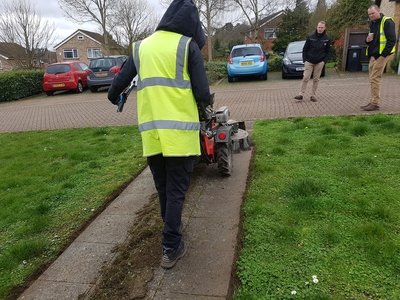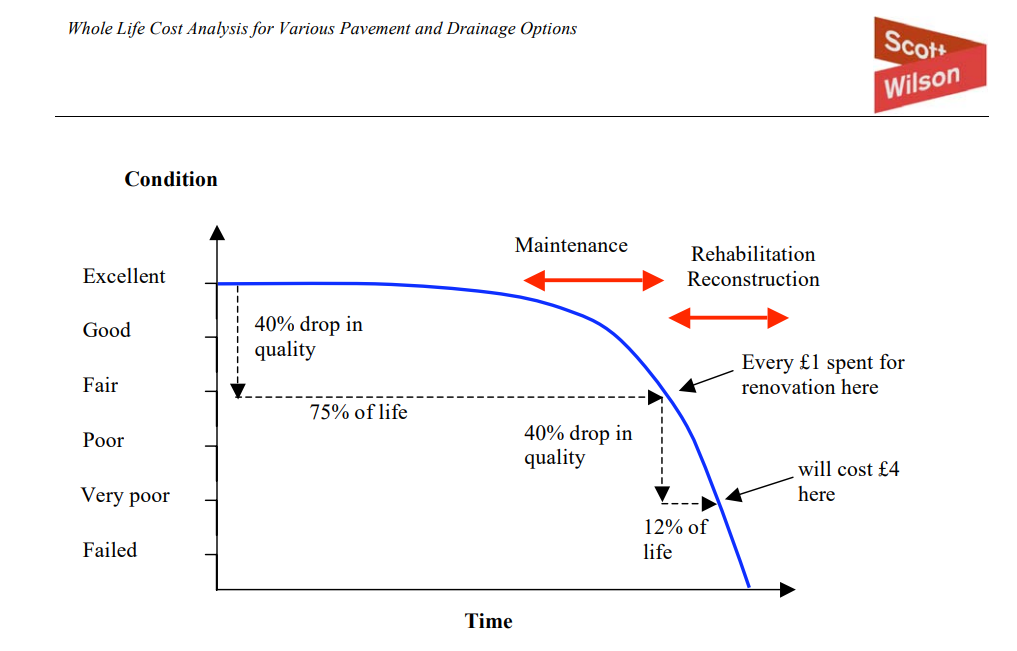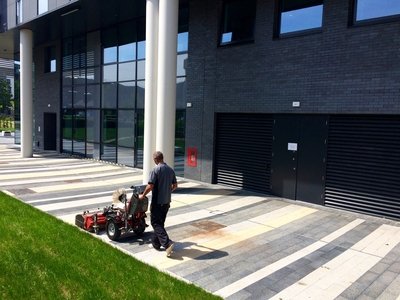Why should we sweep a pavement or footway?
Sweeping is not just for aesthetics, it allows access, improves air quality, improves water quality and also extends the life of a surface.
Sweeping to provide access for pedestrians and wheelchair users
In December 2021, the Department for Transport published an important document entitled;
Inclusive Mobility A Guide to Best Practice on Access to Pedestrian and Transport Infrastructure
Within the guide, it covers the width of footpaths and footways, giving well researched reasons for the required minimum widths.
"Footways and footpaths should be made as wide as is practicable, but under normal circumstances, a width of 2000mm is the minimum that should be provided, as this allows enough space for two wheelchair users to pass, even if they are using larger electric mobility scooters. If this is not feasible due to physical constraints, then a minimum width of 1500mm could be regarded as the minimum acceptable under most circumstances, as this should enable a wheelchair user and a walker to pass each other. Where there is an obstacle, such as lamp columns, sign posts or electric vehicle charging points, the absolute minimum width should be 1000mm, but the maximum length of such a restricted space should be 6 metres."
You can read the full document here;
If we are to ensure that our environments are easily accessible to all, which is an important goal, then this width is not only important when the footway or footpath is installed, but also for the duration of it's life. Encroachment of soil onto pavements of up to several cm per year is not uncommon, especially when bordering areas that produce large volumes of detritus.

The real impact of neglecting these footways and footpaths is huge. "Living Streets research has found that nearly one in three (31%) older adults (aged 65+) are prevented from walking more or at all on their local streets because of cracked and uneven pavements; 48% of older adults say they would walk more if pavements were better maintained."
Here's a link to the document;
https://www.livingstreets.org.uk/media/33ajm1zm/pedestrian-slips-trips-and-falls.pdf
Sweeping to extend the life of a surface and save repair costs
Each local highways authority receives their annual roads maintenance and pothole repair funding from central government. This funding comes from national taxation, including fuel duty. The department for transport is responsible for funding allocation.
In 2023, an annual industry report estimated that 18% of the local road network in England (excluding London) is in poor condition. It predicted that the one-time catch-up cost to clear the backlog of maintenance issues would cost £12.1 billion and take 11 years to complete.
I came across some research showing that maintenance intervention is critical.

The difference in cost between maintenance of a road in just below fair condition, versus one in very poor condition if four fold, so intervening earlier can save £Billions in infrastructure costs very easily. Sweeping is a good starting point. Keeping the surface swept and removing the soil allows the surface to dry out more rapidly, therefore reducing the damaging effects of freezethaw. Establishing routine sweeping will help remove wearing debris, that will slowly polish away the surface if not removed, thus further extending the life of paved roads and paths
I come across many footpaths and pavements in my demonstrations that have had insufficient maintenance for many years. Perhaps they have sprayed the weeds as a token gesture, but the path has not been brushed to remove the encroachment of turf and soil, rendering them much smaller than when originally installed and damaged from freeze-thaw and other natural processes.
Air quality is also an overlooked, but important reason to sweep the pavements and footways.
A study conducted in London found that regular road sweeping can lead to a considerable reduction in particulate matter levels, with a 10% decrease in PM10 levels and a 16% decrease in PM2.5 levels observed in some areas. Similarly, The Environmental Research Group at King’s College London found that road sweeping had a significant impact on PM10 and PM2.5 concentrations, finding road sweeping reduced PM10 concentrations by up to 33% and PM2.5 concentrations by up to 29%.
Sweeping also reduces the amount of other pollutants that may be released into the air. For example, heavy metals such as lead, cadmium, and zinc are often present in road dust and can be harmful to both human health and the environment. Sweeping reduces the amount of these heavy metals on the road surface by up to 85% (MGBA, 2019).

Sweeping also improves Water Quality and prevents flooding
When it rains all the same pollutants we mentioned above, along with others are swept into storm drains which carry the polluted stormwater to catch basins and waterways in the community.
That makes effective street sweeping essential to removing and minimizing the pollutants in stormwater. In fact, street sweeping is a best practice for pollution prevention and removal of pollutants before they enter the stormwater system.
Removal of larger silt and debris also reduces the likelihood of blocking stormwater conveyances, thus reducing the likelihood flooding.
Sweeping the road or and pavement will help reduce noise polution
Street sweeping helps to reduce noise pollution. Removing dirt and dust from the streets can significantly reduce traffic noise levels, allowing people to enjoy their neighborhoods in peace.
Recently the World Health Organization has published a report on Burden of Disease from Environmental Noise (March 2011). A large part of the population of Europe is exposed to high noise levels caused by traffic. This can lead to annoyance, sleep disturbance, health effects, learning difficulties, an amount of lost healthy life years (DALY's) and even mortality. To reduce traffic noise, many measures need to be taken at a local level as well as at the national governmental level.
Processes that can negatively influence the acoustic degradation of low noise road surfaces are loss of stones, ravelling and the reduction of absorption (for open‐graded mixes). Particularly in urban environments road surfaces are very sensitive to these types of damage. There is more torsion and friction movement of the traffic; and lower vehicle speeds mean a reduced self‐cleaning of porous road surfaces. It is recommended that a porous surface is cleaned once or twice a year to prevent clogging. Winter maintenance for silent road surfaces is comparable with what is normally done on porous surfaces. Be aware during the maintenance of the silent road surface that small repairs often have a negative influence on noise reduction.
You can read more here;
https://unece.org/DAM/trans/doc/2014/wp29grb/GRB-60-04e.pdf
For more information on our sweepers, follow this link;
https://kerstenuk.com/Sweeper-range
No comments yet. Login to start a new discussion Start a new discussion